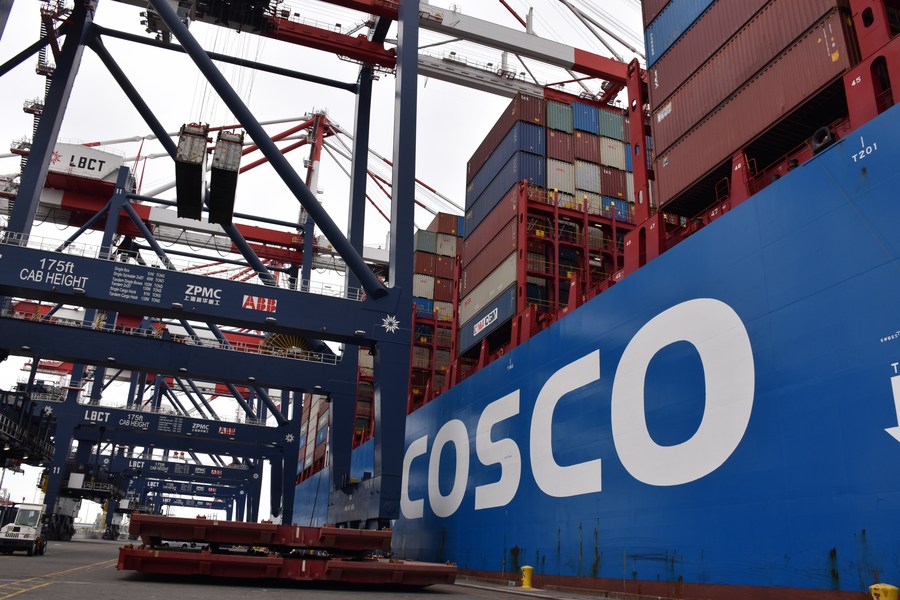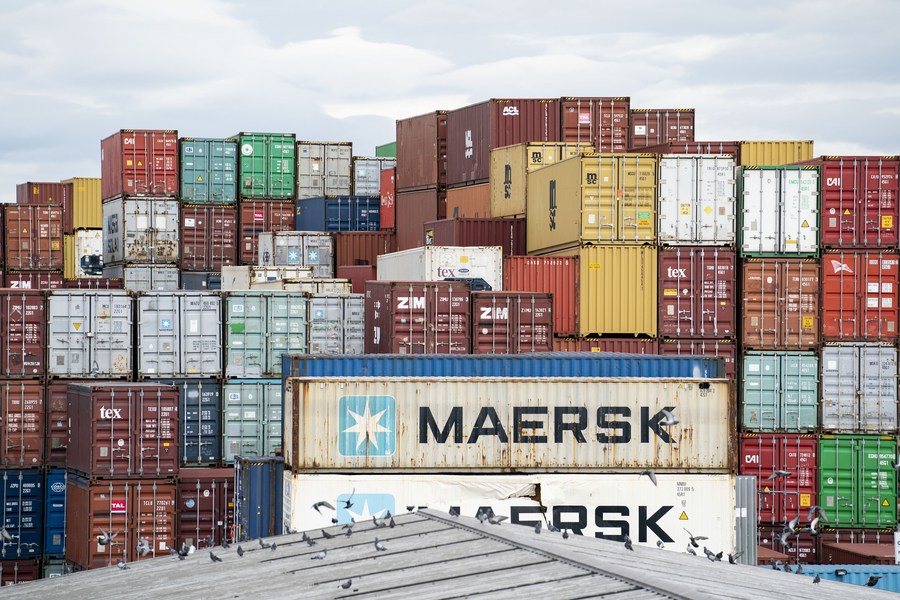
A container ship of China's COSCO Shipping docks at a container terminal of the Port of Long Beach in California, the United States, Aug. 20, 2021. (Xinhua/Gao Shan)
Those so-called "de-risking" attempts have failed in containing China's economic rise or its technological advancements but only made its own supply chains costlier and less efficient in this shock-prone world.
BEIJING, Jan. 13 -- Global supply chains, now at a crucial stage of realignment, are overshadowed by heightened risks of disruptions and fragmentation, thanks to U.S. "de-risking" strategies with China as a main target.
Realizing it is unfeasible to thoroughly "de-couple" from China and create a self-dominated manufacturing and trade network, Washington has been trying to reshuffle global supply chains to lock China out through a series of approaches in the name of "de-risking."
Those approaches include finding replacement countries like Mexico and Vietnam and resorting to tariff barriers, export controls, investment reviews, and domestic legislation such as the Inflation Reduction Act and the CHIPS and Science Act.
It turns out, however, that these so-called "de-risking" attempts have failed in containing China's economic rise or its technological advancements but only made its own supply chains costlier and less efficient in this shock-prone world. As analysts have argued, the U.S. policy, which smacks of economic nationalism and protectionism, may ultimately fail in its objective of reducing dependence on the supply chains with China as a critical link.
ELONGATED WITH HIGHER COSTS
Global supply chains normally act as logistics networks between firms, regardless of their geographical or industrial boundaries, to deliver raw materials, intermediate goods, and finished products to consumers and customers at various levels.
The reality is that oftentimes, U.S. allies or partners, not least in Asia, function as assembly lines, processing plants or packaging hubs for goods and products originally manufactured in China, so as to circumvent U.S. sanctions and tariffs.
By analyzing firm-level network data, the Bank for International Settlements (BIS) has recently revealed that the global value chains have lengthened since late 2021, and the lengthening of supply chains is especially significant for supplier-customer linkages from China to the United States, which suggests that firms from other jurisdictions, notably in Asia, have interposed themselves in the supply chains from China to the United States.
The redirection of China-U.S. supply chains via other Asia-Pacific economies is particularly striking in the IT industry, where the share of cross-country linkages is one of the highest, BIS said in a report in October last year.
Little surprise that those countries first import Chinese intermediate goods, and then export finished products to the United States and other Western countries, elongating corresponding supply chains with extra links that could have been shunned otherwise.
China remains embedded in U.S. supply chains, even as American firms have taken steps to reduce direct imports from China, according to a paper presented at the Federal Reserve Bank of Kansas City's annual Jackson Hole conference in August 2023.
In this regard, Apple provides a prime example of how hard it would be for multinationals to disengage their supply chains from China. Although the consumer technology giant is working to move manufacturing outside China over the past years, much of its production still relies on Chinese companies.
Of the top 200 suppliers that account for 98 percent of Apple's global procurement, manufacturing and assembly businesses, 151 have production activities in China.
In terms of equipment, about 75 percent of Apple supply chains' spending on smart manufacturing equipment is used to buy Chinese-developed intelligent production equipment.
Equally palpable is that the abrupt relocation of U.S. supply chains from China to intermediaries resulted in much higher costs and increasingly complex trade networks for U.S. buyers, who thereby fall victim to mounting uncertainties and price volatility.
The Centre for Economic Policy Research (CEPR), a European think tank, elaborated in a recent report that the reallocation of trade to other countries has been associated with significant increases in import prices from these alternative sources. In the United States, the policies to encourage shifts in sourcing patterns may well contribute to wage and cost pressures.
To be specific, the think tank estimated that a 5 percentage-point trade-weighted average decrease across products in the share of U.S. imports from China is associated with a 9.8 percent and 3.2 percent rise in the unit prices of imports from Vietnam and Mexico, respectively.
Besides, instead of being more resilient, the elongated global supply chains have caused such difficulties as less transparency and dampening efficiency for companies to operate, monitor and supervise the flow of goods and capital.
BIS pointed out in its report that the overall lengthening of firm distances has not been accompanied by an increase in the density of the network as a whole, indicating that supplier relationships are not diversifying. That's because the average out-degree, which represents the mean number of customers for each supplier, has not seen an increase.
CHINA AS INDISPENSABLE LINK
China, as observers have perceived, remains integral to the growingly intertangled global supply chains.

Containers are seen at the Port of Baltimore in Maryland, the United States, Oct. 26, 2021. (Xinhua/Liu Jie)
The cold reality is that much production in Asia and part of that in Europe and Mexico rides on Chinese imports and investment, notwithstanding the larger market shares they have in global trade with the United States.
In recent years, China's booming exports of the "new three" speaks volumes. The three major tech-intensive green products -- solar batteries, lithium-ion batteries and electric vehicles -- stand as an eloquent testimony to China's manufacturing prowess and strong presence in global supply chains.
According to the European Automobile Manufacturers' Association, China is the third largest market for European Union (EU) EV exports after Britain and the United States.
On top of those "Made in China," Western EV manufacturers also purchase various raw materials and components from China, most notably batteries, a component reputed to be the heart of an EV. Nowadays, of the top 10 power battery sellers in the world, more than half of them come from China.
Stellantis, the world's fourth largest automotive group, and Chinese battery manufacturer Contemporary Amperex Technology signed in November 2023 a non-binding Memorandum of Understanding for the local supply of lithium iron phosphate battery cells and modules to power Stellantis' electric vehicle production in Europe.
While the United States has cut direct reliance on China via imports, China has increased its import market share in third countries, including all the top-five import partners of the United States, except Japan, CEPR said in the above report.
"To the extent that Chinese firms' exports to these other locations involve components assembled into later-stage goods that are then sent to the U.S. market, China would ultimately continue to be a relevant player in the upstream stages of U.S. supply chains," the think tank noted.
MORE RISKS OF FRAGMENTATION
For global firms and investors, the increasingly diversified delivery routes in global supply chains come with more risks meriting prudent assessment. Stability, fairness, transparency and predictability, among others, are all important criteria for assessing a country's business environment.
In a forecast last month, the United Nations Conference on Trade and Development (UNCTAD) said that the outlook for global trade in 2024 remains "highly uncertain" and "generally pessimistic," and predicted that global trade in 2023 would fall by around 5 percent compared to 2022.
Mounting geopolitical tensions, an uptick in trade-restrictive measures, elongated supply chains, and commodity price volatility were among the factors weighing on trade, UNCTAD warned.
In its World Economic Outlook 2023, the International Monetary Fund (IMF) used "fragmentation" over 170 times to refer to the splintering of countries into blocs that trade and cooperate exclusively with each other.

Photo taken on April 6, 2021 shows an exterior view of the International Monetary Fund (IMF) headquarters in Washington, D.C., the United States. (Photo by Ting Shen/Xinhua)
The IMF cautioned that intensifying geoeconomic fragmentation -- in various forms of trade tariffs, technological decoupling, limited capital flows and migration restrictions -- will raise costs, cause price volatility, and impede both portfolio flows and foreign direct investment.
In an interview earlier this month, IMF Managing Director Kristalina Georgieva warned against fragmentation of the global economy along geopolitical lines due to increasing national security restrictions, with countries gravitating towards separate blocs. Allowed to continue, it could ultimately reduce global GDP by 7 percent, she said.
"Policymakers need to focus on the issues that matter most not only to the wealth of nations but also to the economic well-being of ordinary people," Georgieva wrote in a recent article in Foreign Affairs magazine.
"They must nurture the bonds of trust among countries wherever possible so they can quickly step up cooperation when the next major shock comes," she noted.











